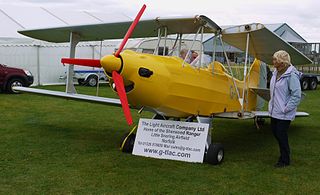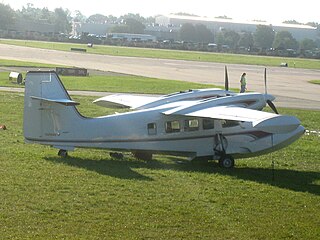
| Type | aircraft design and manufacture |
|---|---|
| Fate | ceased aircraft production |
| Founded | 1965 |
| Defunct | c. 1985 |
| Headquarters | Parramatta, Sydney |
| Parent | Transfield |
Transavia Corporation was an Australian aircraft manufacturer active between 1965 and 1985.

| Type | aircraft design and manufacture |
|---|---|
| Fate | ceased aircraft production |
| Founded | 1965 |
| Defunct | c. 1985 |
| Headquarters | Parramatta, Sydney |
| Parent | Transfield |
Transavia Corporation was an Australian aircraft manufacturer active between 1965 and 1985.
Transavia Corporation was formed in 1965, as a subsidiary of Transfield to produce agricultural aircraft.
The initial design of the Airtruck had been done in New Zealand by Luigi Pellarini in 1956 as the single Kingsford Smith PL-7 tanker aircraft. This used parts from T-6 Texan aircraft and a Cheetah engine. Two further more refined PL-11 Airtruck aircraft were built in New Zealand during the early 1960s by Bennett Aviation, later Waitomo Aircraft. [1]
The design was taken over by Transavia Corporation in 1965 and the company refined the aircraft's specification as the Transavia PL-12 Airtruk.

The PL-12 had an unconventional but practical layout for its intended agricultural top-dressing role. The basic layout was inherited from the PL-11. This was a mid-wing monoplane, but with a small lower "wing" that carried the wing bracing struts and the two main wheels of the tricycle undercarriage. Slender booms carried the two separate tailplanes on top of the fin/rudder units. The two booms were not joined together at the aircraft's rear. [2]
The cockpit was located on top of a stubby fuselage, giving good visibility for low-level flying and the chemical hopper was situated below the pilot with a loading aperture just behind the cockpit. A cargo carrying utility version was also built. Power for early production was from a Continental IO-520-D 300 h.p. engine.
Further refinements in design in 1981 brought the PL-12-300 "Skyfarmer" with strengthened upper fuselage and a larger cockpit with roll-over truss. The final derivative was the PL-12-400 with a Lycoming I0-720 400 h.p. engine, larger dorsal fin and lower sesquiplane "wings". Total Airtruk production by Transavia was 118 aircraft. Examples are still in active operation. [3]

The empennage, also known as the tail or tail assembly, is a structure at the rear of an aircraft that provides stability during flight, in a way similar to the feathers on an arrow. The term derives from the French language word empenner which means "to feather an arrow". Most aircraft feature an empennage incorporating vertical and horizontal stabilising surfaces which stabilise the flight dynamics of yaw and pitch, as well as housing control surfaces.

A twin tail is a specific type of vertical stabilizer arrangement found on the empennage of some aircraft. Two vertical stabilizers—often smaller on their own than a single conventional tail would be—are mounted at the outside of the aircraft's horizontal stabilizer. This arrangement is also known as an H-tail, as it resembles a capital "H" when viewed from rear - these were used on a wide variety of World War II multi-engine designs that saw mass production, especially on the American B-24 Liberator and B-25 Mitchell bombers, the British Avro Lancaster and Handley-Page Halifax heavy bombers, and on the Soviet Union's Petlyakov Pe-2 attack bomber.

In a fixed-wing aircraft, the spar is often the main structural member of the wing, running spanwise at right angles to the fuselage. The spar carries flight loads and the weight of the wings while on the ground. Other structural and forming members such as ribs may be attached to the spar or spars, with stressed skin construction also sharing the loads where it is used. There may be more than one spar in a wing or none at all. However, where a single spar carries the majority of the forces on it, it is known as the main spar.

The PL-11 Airtruck is a New Zealand agricultural aircraft.

The Transavia PL-12 Airtruk is a single-engine agricultural aircraft designed and built by the Transavia Corporation in Australia. The Airtruk is a shoulder-wing strut braced sesquiplane of all-metal construction, with the cockpit mounted above a tractor-location opposed-cylinder air-cooled engine and short pod fuselage with rear door. The engine cowling, rear fuselage and top decking are of fibreglass. It has a tricycle undercarriage, the main units of which are carried on the lower sesquiplane wings. It has twin tail booms with two unconnected tails. Its first flight was on 22 April 1965, and was certified on 10 February 1966.

VL Viima, constructed by the State Aircraft Factory is a Finnish two-seat, biplane trainer used by the Finnish Air Force from the late 1930s to the early 1960s. After military service, several were released into civil use.

The Mooney M22 Mustang is the first attempt at a pressurized single engine aircraft by the Mooney Aircraft Company of the United States.

The Alaparma Baldo was an unusual two-seat light monoplane produced in Italy shortly after World War II. Designed by Adriano Mantelli, it featured an egg-shaped fuselage with cabin doors that hinged upwards and to the back. The conventional tailplane with single fin and rudder was carried on twin booms, either side of a pusher engine installation. The undercarriage consisted of a single mainwheel under the fuselage pod, a small tailwheel not far behind it, and outrigger wheels on the wingtips.

The Bristol Gordon England biplanes were a series of early British military biplane aircraft designed by Gordon England for the Bristol Aeroplane Company that first flew in 1912. Designed for easy ground transport, the aircraft could be quickly disassembled.

The Beechcraft Model 34 "Twin-Quad" was a prototype airliner designed and built by Beechcraft in the period between World War II and the Korean War. At this time many aircraft manufacturers in the United States anticipated a boom in civil aviation and a large number of designs left the drawing board only to ultimately fail. The Model 34 was one of these failures, partly because of its unusual design, and partly because of the thousands of ex-military transport aircraft that were available at the time for a fraction of the price of a new aircraft.

The Southern Cross SC-1 was an Australian civil aircraft.

The Remos G3 Mirage and Remos GX are German high wing, two seat, single engine light aircraft, built by Remos AG of Pasewalk. The aircraft is supplied as a kit for amateur construction or complete and ready-to-fly.
The Pazmany PL-4A is a single-seat, single-engine sport aircraft developed in the United States and first flown in 1972. It is marketed for homebuilding from plans, and 686 sets had sold by 1985. The PL-4A is a conventional, low-wing cantilever monoplane with an enclosed cabin and fixed, tailwheel undercarriage. The design features a T-tail, chosen to facilitate folding the wings. Construction throughout is of metal, using standard extruded sections for the longerons and pop rivets as the basic fastener. The standard powerplant is a Volkswagen air-cooled engine of 60 hp (45 kW) Construction time is estimated to be around 1,000–1,500 hours.

The Scintex ML 250 Rubis was a French civil utility aircraft of the 1960s.

The CFM Shadow is a British ultralight aircraft designed in the 1980s. It is of high wing, pusher, pod and boom layout and seats two. About 400 have been built.
The Alpha J-5 Marco is a single-seat airplane in pod-and-boom pusher configuration. Kits were built in Poland and the aircraft has been exported to several countries including Germany and the USA.

The Tiger Cub Developments (TCD) Sherwood Ranger is a single engine, tandem two seat biplane microlight designed and built in the United Kingdom in the early 1990s. Kits were originally produced by TCD; later, design rights were acquired by The Light Aircraft Company Ltd (TLAC) who resumed kit production in 2009.

The Ellison-Mahon Gweduck is a modern, twin engine amphibious aircraft, built from composites and closely resembling the Grumman Widgeon. It was designed and is built in the United States and was first flown in 2009.

The Coupé-Aviation JC-01 is the first of a series of very similar designs of two seat, single engine sports aircraft, amateur built from plans in France from 1976. These provided a range of engine sizes and undercarriage layouts, but total production was small.
The Morane-Saulnier MS.300 and MS.301 were French parasol wing introductory trainer aircraft, first flown in 1930. They differed only in engine type. Neither reached production but were developed into two similar trainers, the MS.230 and MS.315, which were made in large numbers.
| Wikimedia Commons has media related to Transavia Corporation . |